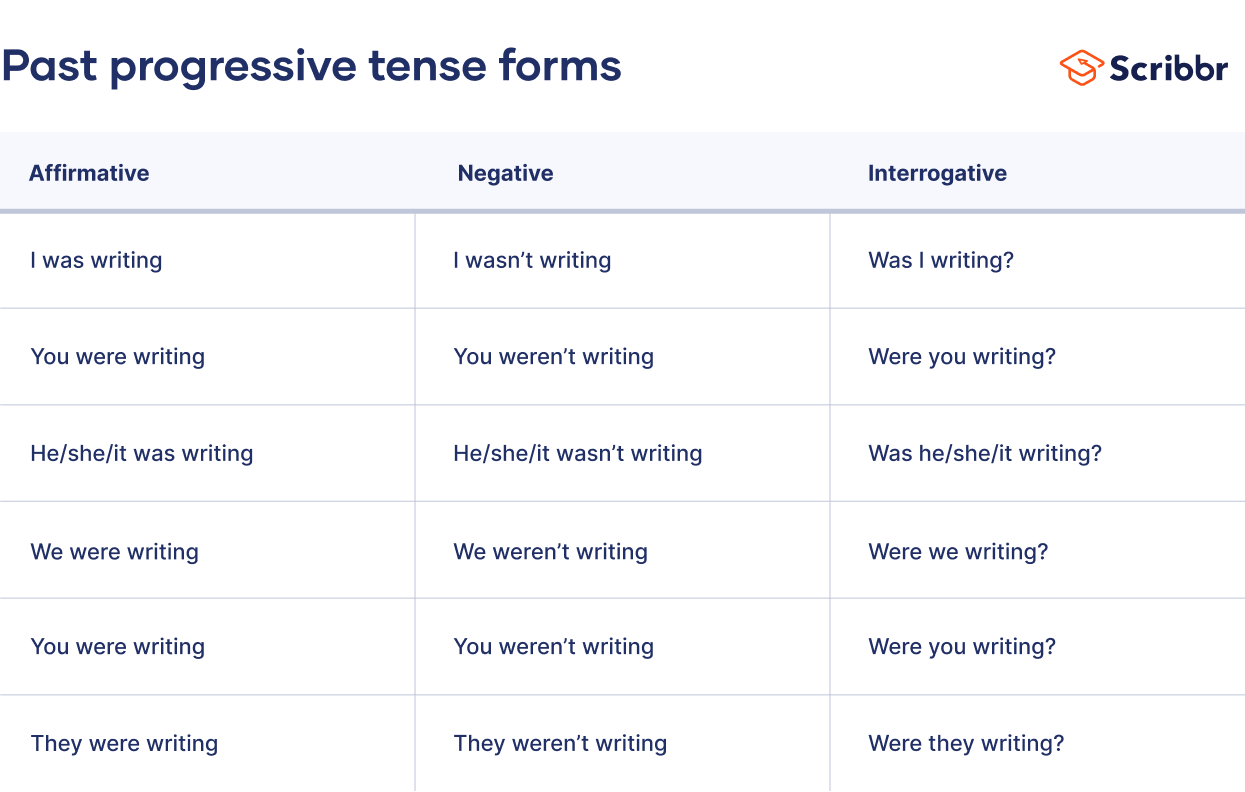Past Progressive Tense | Uses, Examples & Worksheet
The past progressive tense is a verb form used to refer to an action that was ongoing at a time in the past.
The past progressive is formed using the past tense of the auxiliary verb “be” (i.e., “was/were”) along with the present participle (“ing” form) of a main verb (e.g., “I was thinking”).
How to use the past progressive tense
The past progressive tense (also called the past continuous) is formed using “was/were” and the present participle form of the main verb (e.g., “I was singing”).
The past progressive tense is used to refer to an ongoing past action that was interrupted by another past action (in the simple past tense) or to two past actions that were taking place at the same time.
It can also be used to indicate that something was habitual (usually in a critical way).
While John was cooking dinner, Mary was cleaning the house.
David was always complaining about something.
- “While” is typically used before a past progressive form to indicate that two actions were taking place simultaneously (e.g., “I was gardening while it was raining”).
- “When” is typically used before a past simple form to indicate that this action interrupted another ongoing action (e.g., “Jean was reading when the phone rang”).
It’s important to note that only one of these conjunctions is typically used in a sentence. Using both conjunctions in the same sentence will confuse your meaning.
Past simple vs past continuous
Both the past simple and past continuous are used to talk about past action. However, they have different functions:
- The past simple is used to indicate that an action was completed in the past.
- The past continuous is used to emphasise that an action was ongoing in the past. Sentences that use the past continuous often contain a clause in the past simple to indicate that the ongoing action was interrupted by another action.
I was cycling home from work when I fell off my bike.
- I was wanting to go home.
- I wanted to go home.
- I had wanted to go home.
How to form negatives
In the past continuous, negative statements are formed by adding the adverb “not” after the auxiliary verb “was/were”. This is often contracted (e.g., “wasn’t/weren’t”).
John felt that he wasn’t reaching his full potential.
How to form questions
To ask a yes–no question using the past continuous, put “was/were” before the subject of the sentence, followed by the present participle of the main verb.
Were you studying when the power went out?
To ask a question starting with a wh-word (an interrogative pronoun like “who” or an interrogative adverb like “when”), follow the same order as above, but add the pronoun or adverb at the start of the sentence.
What were you expecting?
How to form the passive voice
Passive constructions are ones in which the subject of the sentence is acted upon, rather than performing the action.
Passive sentences in the past continuous tense are formed using a subject, the auxiliary verbs “was/were” and “being”, along with the past participle of the main verb.
The guests were being served when a fire broke out in the kitchen.
The suspect was being questioned by the police when another bank was robbed.
Worksheet: Past progressive tense
Practise using the past progressive correctly with the exercises below. In the blank space in each sentence, fill in the correct past progressive form based on the subject and verb specified (e.g., “[he / walk]” becomes “he was walking”). Some answers may also be negative statements, questions, or passive constructions.
- __________ [I / cook] when you called.
- __________ [they / sunbathe] while I was setting up the grill.
- __________ [you / not / work] yesterday.
- __________ [The bank / rob] when the police arrived on the scene.
- What __________ [you / do] this morning?
- I was cooking when you called.
- The past progressive is formed using the past tense of “be” (i.e., “was/were”) and the present participle (“ing” form) of a main verb. In this instance, the past progressive is used to refer to an ongoing past action that was interrupted by another action.
- They were sunbathing while I was setting up the grill.
- In this instance, the past progressive is used to refer to two actions that were taking place at the same time in the past.
- You were not working yesterday.
- In the past progressive, negative statements are formed by adding “not” after “was/were”.
- The bank was being robbed when the police arrived on the scene.
- Passive sentences in the past progressive are formed using a subject (“the bank”), the auxiliary verbs “was/were” and “being”, along with the past participle of the main verb (“robbed”).
- What were you doing this morning?
- To ask a question starting with a wh-word, add the wh-word at the start of the sentence, followed by “was/were”, the subject of the sentence (“you”), and the present participle of the main verb (e.g., “doing”).
Other interesting articles
If you want to know more about fallacies, research bias, or AI tools, make sure to check out some of our other articles with explanations and examples.
AI tools
Fallacies
Frequently asked questions about the past progressive tense
Sources for this article
We strongly encourage students to use sources in their work. You can cite our article (APA Style) or take a deep dive into the articles below.
This Scribbr articleRyan, E. (2023, November 01). Past Progressive Tense | Uses, Examples & Worksheet. Scribbr. Retrieved 2 July 2025, from https://www.scribbr.co.uk/verb/past-progressive-tense/
Aarts, B. (2011). Oxford modern English grammar. Oxford University Press.
Butterfield, J. (Ed.). (2015). Fowler’s dictionary of modern English usage (4th ed.). Oxford University Press.
Garner, B. A. (2016). Garner’s modern English usage (4th ed.). Oxford University Press.




